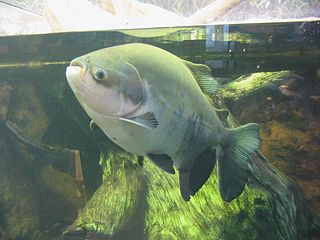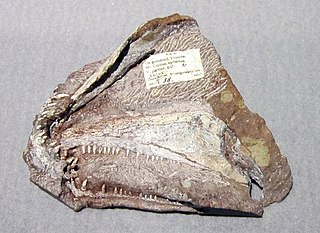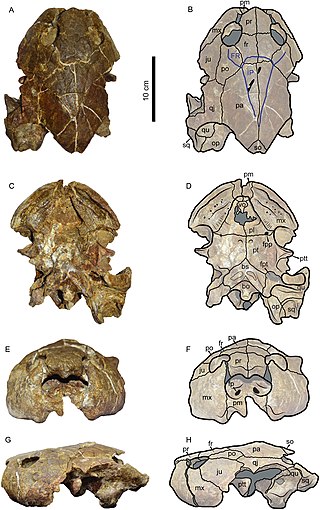
A piranha or piraña is any of a number of freshwater fish species in the family Serrasalmidae, or the subfamily Serrasalminae within the tetra family, Characidae in order Characiformes. These fish inhabit South American rivers, floodplains, lakes and reservoirs. Although often described as extremely predatory and mainly feeding on fish, their dietary habits vary extensively, and they will also take plant material, leading to their classification as omnivorous.

Otodus megalodon, commonly known as megalodon, is an extinct species of giant mackerel shark that lived approximately 23 to 3.6 million years ago (Mya), from the Early Miocene to the Early Pliocene epochs. O. megalodon was formerly thought to be a member of the family Lamnidae and a close relative of the great white shark, but has been reclassified into the extinct family Otodontidae, which diverged from the great white shark during the Early Cretaceous.

Serrasalmus is a genus of piranhas. They are collectively known as pirambebas; the "typical" piranhas like the piraya piranha are nowadays placed in Pygocentrus. Like all piranhas, Serrasalmus are native to South America.

Helicoprion is an extinct genus of shark-like eugeneodont fish. Almost all fossil specimens are of spirally arranged clusters of the individuals' teeth, called "tooth whorls", which in life were embedded in the lower jaw. As with most extinct cartilaginous fish, the skeleton is mostly unknown. Fossils of Helicoprion are known from a 20 million year timespan during the Permian period from the Artinskian stage of the Cisuralian to the Roadian stage of the Guadalupian. The closest living relatives of Helicoprion are the chimaeras, though their relationship is very distant. The unusual tooth arrangement is thought to have been an adaption for feeding on soft bodied prey, and may have functioned as a deshelling mechanism for hard bodied cephalopods such as nautiloids and ammonoids. In 2013, systematic revision of Helicoprion via morphometric analysis of the tooth whorls found only H. davisii, H. bessonowi and H. ergassaminon to be valid, with some of the larger tooth whorls being outliers.

Pygocentrus piraya, often called the piraya piranha or San Francisco piranha, and sometimes sold as the man-eating piranha, is a large, aggressive piranha from the São Francisco River basin in Brazil.

Pacu is a common name used to refer to several species of omnivorous South American freshwater serrasalmid fish related to piranhas. Pacu and piranha do not have similar teeth, the main difference being jaw alignment; piranha have pointed, razor-sharp teeth in a pronounced underbite, whereas pacu have squarer, straighter teeth and a less severe underbite, or a slight overbite. Pacu, unlike piranha, mainly feed on plant material and not flesh or scales. Additionally, the pacu can reach much larger sizes than piranha, at up to 1.08 m in total length and 40 kg (88 lb) in weight.

The sharp-snouted piranha is a species of serrasalmid endemic to Peru. It is part of the S. rhombeus complex. It reaches a maximum size of around 7 inches (18 cm). Individuals often exhibit a red throat, similar to that of Pygocentrus nattereri. It is also known as ruby-throated diamond piranha or "ruby-red piranha"; the latter name is also used for the speckled piranha.

The Serrasalmidae (serrasalmids) are a family of characiform fishes, recently elevated to family status. It includes more than 90 species. The name means "serrated salmon family", which refers to the serrated keel running along the belly of these fish. Fish classified as Serrasalmidae are also known by these common names: pacu, piranha, and silver dollar. These common names generally designate differing dental characteristics and feeding habits.

Pliosaurus is an extinct genus of thalassophonean pliosaurid known from the Late Jurassic of Europe and South America. Most European species of Pliosaurus measured around 8 metres (26 ft) long and weighed about 5 metric tons, but P. rossicus and P. funkei would have been one of the largest plesiosaurs of all time, exceeding 10 metres (33 ft) in length. This genus has contained many species in the past but recent reviews found only six to be valid, while the validity of two additional species awaits a petition to the International Code of Zoological Nomenclature. Currently, P. brachyspondylus and P. macromerus are considered dubious, while P. portentificus is considered undiagnostic. Species of this genus are differentiated from other pliosaurids based on seven autapomorphies, including teeth that are triangular in cross section. Their diet would have included fish, cephalopods, and marine reptiles.

Piaractus brachypomus also known as the red-bellied Pacu or pirapitinga, is a large species of pacu, a close relative of piranhas and silver dollars, in the serrasalmid family. It is native to the Amazon basin in tropical South America, but it formerly included populations in the Orinoco, which was described in 2019 as a separate species, P. orinoquensis. Additionally, P. brachypomus is widely farmed and has been introduced to other regions. In South Florida they are invasive in rivers, canals or lakes.
Tometes is a genus of fish in the family Serrasalmidae found in fast-flowing rivers in northern South America. Adults of all seven species in this genus are phytophagous, feeding primarily on aquatic plants in the family Podostemaceae.

Ymeria is an extinct genus of early stem tetrapod from the Devonian of Greenland. Of the two other genera of stem tetrapods from Greenland, Acanthostega and Ichthyostega, Ymeria is most closely related to Ichthyostega, though the single known specimen is smaller, the skull about 10 cm in length. A single interclavicle resembles that of Ichthyostega, an indication Ymeria may have resembled this genus in the post-cranial skeleton.

Gnatusuchus is an extinct genus of caiman represented by the type species Gnatusuchus pebasensis from the Middle Miocene Pebas Formation of Peru. Gnatusuchus lived about 13 million years ago (Ma) in a large wetland system called the Pebas mega-wetlands that covered over one million square kilometers of what is now the Amazon Basin.

Arisierpeton is an extinct genus of synapsids from the Early Permian Garber Formation of Richards Spur, Oklahoma. It contains a single species, Arisierpeton simplex.
Myloplus nigrolineatus is a species of freshwater fish in the serrasalmid family of order Characiformes. It is native to the Amazon River basin in South America.
Alligator hailensis, or Haile alligator, is a large, extinct species of Alligator known from the early Pleistocene of Florida. It is named after the town of Haile, Florida, where it was found. Its age and skeletal morphology is intermediate between the geologically older Alligator mefferdi and the modern American alligator, making it a transitional fossil.

Caninemys is an extinct genus of large freshwater side-necked turtle, belonging to the family Podocnemididae. Its fossils have been found in Brazil and Colombia, in rocks dating back from the middle to late Miocene.

Kyhytysuka is an extinct genus of ophthalmosaurian ichthyosaur from Early Cretaceous Colombia. The animal was previously assigned to the genus Platypterygius, but given its own genus in 2021. Kyhytysuka was a mid-sized ophthalmosaurian with heterodont dentition and several adaptations suggesting that it was a macropredatory vertebrate hunter living in shallow waters. It contains a single species, Kyhytysuka sachicarum.

Monquirasaurus is an extinct genus of giant short-necked pliosaurs who lived during the Early Cretaceous (Aptian) in what is now Colombia. One species is known, M. boyacensis, described in 2021 from an almost complete fossil skeleton, discovered in 1977 in the town of Villa de Leyva, located in Boyacá. Published descriptions of the holotype specimen estimate that it should reach a total size approaching 9–11 m (30–36 ft) in length and weighing 9–14 metric tons, making Monquirasaurus a large representative of the pliosaurids.

Paredestus is a monotypic genus of extinct eugeneodont holocephalan from the Early Triassic of Canada. The type and only species, P. bricircum represents the last known member of the superfamily Edestoidea and among the last known eugeneodonts. It was named in 2008 based on tooth and jaw material, with the holotype representing the only known specimen.



















